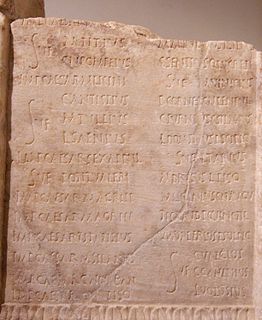Related Research Articles
This article concerns the period 79 BC – 70 BC.
Year 224 BC was a year of the pre-Julian Roman calendar. At the time it was known as the Year of the Consulship of Torquatus and Flaccus. The denomination 224 BC for this year has been used since the early medieval period, when the Anno Domini calendar era became the prevalent method in Europe for naming years.
Year 225 BC was a year of the pre-Julian Roman calendar. At the time it was known as the Year of the Consulship of Papus and Regulus. The denomination 225 BC for this year has been used since the early medieval period, when the Anno Domini calendar era became the prevalent method in Europe for naming years.

The First, Second, and Third Samnite Wars were fought between the Roman Republic and the Samnites, who lived on a stretch of the Apennine Mountains south of Rome and north of the Lucanians.

The gens Atilia, sometimes written Atillia, was a plebeian family at ancient Rome, which rose to prominence at the beginning of the fourth century BC. The first member of this gens to attain the consulship was Marcus Atilius Regulus, in 335 BC. The Atilii continued to hold the highest offices of the state throughout the history of the Republic, and well into imperial times.

The gens Aemilia, originally written Aimilia, was one of the greatest patrician families at ancient Rome. The gens was of great antiquity, and claimed descent from Numa Pompilius, the second King of Rome. Its members held the highest offices of the state, from the early decades of the Republic to imperial times. The Aemilii were almost certainly one of the gentes maiores, the most important of the patrician families. Their name was associated with three major roads, an administrative region of Italy, and the Basilica Aemilia at Rome.
Lucius Manlius Vulso Longus was a Roman general and statesman, who became consul in 256 and 250 BC. He has been remembered as another militarily successful Roman consul; his military achievements significantly contributed to the victory of the Romans in the First Punic War.
Gaius Terentius Varro was a Roman politician and general active during the Second Punic War. A plebeian son of a butcher, he was a populist politician who was elected consul for the year 216 BC. While holding that office, he was decisively defeated by Hannibal at the Battle of Cannae.
Maharbal was a Numidian army commander in charge of the cavalry under Hannibal and his second-in-command during the Second Punic War. Maharbal was a very close friend to Hannibal and admired him greatly. He was often critical to the battlefield success of Carthage over Rome. Throughout his Italian campaign Hannibal maintained numerical superiority in cavalry, and thus relied upon them and Maharbal to give his army an advantage.

The Battle of Telamon was fought between the Roman Republic and an alliance of Celtic tribes in 225 BC. The Romans, led by the consuls Gaius Atilius Regulus and Lucius Aemilius Papus, defeated the Celts led by the Gaesatae kings Concolitanus and Aneroëstes. This removed the Celtic threat from Rome and allowed the Romans to extend their influence over northern Italy.

The Battle of Faesulae was fought in 225 BC between the Roman Republic and a group of Gauls living in Italy. The Gauls defeated the Romans, but later the same year, a decisive battle at Telamon had the opposite outcome.

Marcus Atilius Regulus was a Roman statesman and general who was a consul of the Roman Republic in 267 BC and 256 BC.
Marcus Atilius Regulus, a son of Marcus Atilius Regulus, the consul captured during the First Punic War, and a grandson of Marcus Atilius Regulus, was a Roman consul for the year 227 BC, together with Publius Valerius Flaccus, and was a consul suffectus in 217 BC, replacing Gaius Flaminius, who was killed in battle at Lake Trasimene.

The Insubres or Insubri were an ancient Celtic population settled in Insubria, in what is now the Italian region of Lombardy. They were the founders of Mediolanum (Milan). Though completely Gaulish at the time of Roman conquest, they were the result of the fusion of pre-existing Ligurian and Celtic population with Gaulish tribes.
Aneroëstes was one of the two leaders of the Gaesatae, a group of Gaulish mercenaries who lived in the Alps near the Rhône and fought against the Roman Republic in the Battle of Telamon of 225 BC. He and his colleague Concolitanus were hired by the Boii and Insubres in response to the Roman colonisation of the formerly Gallic region of Picenum. After some initial success in Etruria, when faced with the army of the consul Lucius Aemilius Papus, Aneroëstes persuaded the Gauls to withdraw, but they were cut off at Telamon by the other consul, Gaius Atilius Regulus, and forced to fight a pitched battle.
The Gaesatae or Gaesati were a group of Gallic mercenary warriors who lived in the Alps near the river Rhône and fought against the Roman Republic at the Battle of Telamon in 225 BC.
Lucius Aemilius Papus was a Roman general and statesman. He jointly commanded the Roman armies which defeated the Gauls at the Battle of Telamon in 225 BC; his co-Consul, Gaius Atilius Regulus was killed during the battle. Papus was honoured with a triumph for this victory. He subsequently held several senior positions. He belonged to the patrician gens Aemilia.

The gens Caedicia was a plebeian family at ancient Rome. Members of this gens first came to prominence in the early decades of the Republic, but none obtained the consulship until Quintus Caedicius Noctua in 289 BC. The family faded from public life during the later Republic, but one of the Caedicii was known to Juvenal, toward the end of the first century AD.
References
- ↑ William Smith, Dictionary of Greek and Roman Biography and Mythology , 1870, "G. Atilius M. f. M. n. Regulus" Archived 2008-06-28 at the Wayback Machine
- ↑ "Polybius • Histories — Book 2". penelope.uchicago.edu. Retrieved 2017-07-30.
- ↑ Polybius, Histories, 2.27
- ↑ Polybius, Histories, 2.28